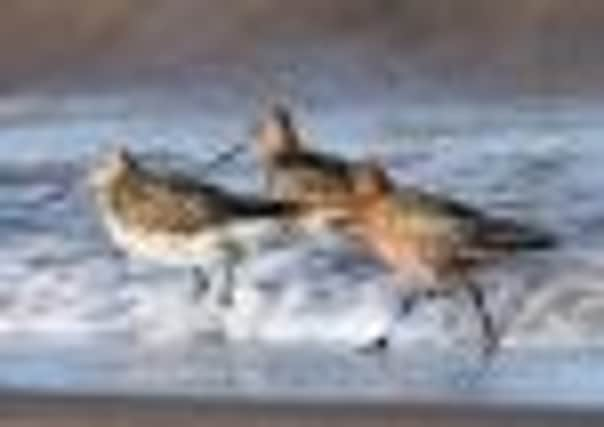Birdwatch: Godwits make a welcome return


In full breeding plumage, both are an impressive mix of black, white and deep brick red, and some of the birds being seen now are already showing much of this finery.
The red plumage is more uniform in the bar-tailed, covering all the head, neck and belly, while in the black-tailed, it is confined to the head and neck, the breast and belly being black and buff-barred.
Advertisement
Hide AdAdvertisement
Hide AdBoth have long, straight beaks with the bar-tailed’s turning up very slightly at the end.
They breed in quite different areas. The black-tailed breeds from Iceland east across Eurasia with a small but increasing number of some 100 pairs breeding in East Anglia and the occasional pair in the Lower Derwent Valley, between York and Selby, where 45 were present this week.
These breeding birds belong to the limosa race, whose nearest strongholds to us are in the Netherlands but the majority of birds seen on passage here belong to the Icelandic race, islandica.
The bar-tailed godwit breeds further north than the black-tailed on the Arctic tundra in Lapland, north-east Russia and Siberia, and birds on passage there are almost always seen on estuaries such as the Humber, although there are occasional inland sightings with three seen recently at Potteric Carr.
Advertisement
Hide AdAdvertisement
Hide AdBoth godwits have a global distribution, and the bar-tailed takes a huge migration across the Pacific from Alaska to New Zealand. Up to 3,500 fly directly across the Pacific, an 11,000 km non-stop journey which the fastest take only eight days to complete.
The New Zealanders recognised this feat with a charming tradition in the city of Christchurch where the cathedral bells were rung for half-an-hour each September to herald the arrival back of the first wintering bar-tailed godwits on the Avon-Heathcote estuary, a herald of the New Zealand spring, with a similar ceremony to mark their departure on the same gruelling journey back to their Alaskan breeding grounds the following March.
February’s earthquake, which destroyed the Christchurch’s cathedral spire, has put a stop to this tradition, but I am sure, like much of this wonderful city, it will eventually be restored.
Two common cranes were seen at the Saltholme reserve, on Teesside, over the A1 near Boroughbridge, in the Lower Derwent Valley and at Tophill Low.
Advertisement
Hide AdAdvertisement
Hide AdThe first garganey ducks of the year have returned with two at Potteric Carr and two at Wombwell Ings, South Yorkshire.
Black redstarts, wheatears and two firecrests were seen in the Spurn area, while a Sandwich tern was seen off Barmston.
One or two swallows and house martins have been reported, along with increasing numbers of sand martins, while a singing common redstart was reported on a building at Ripon racecourse, and a male ring ouzel was seen at Warley Moor reservoir, near Denholme, Bradford.
Marsh harriers are busily displaying at Blacktoft Sands with five on the reserve so far, including two males, while two Mediterranean gulls are now back at the Old Moor reserve, South Yorkshire.
Waxwings continue to be seen across the region with flocks reported in Skipton, Sheffield, York and Huddersfield.